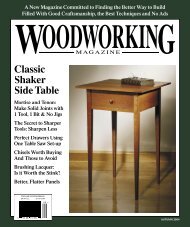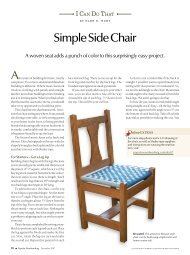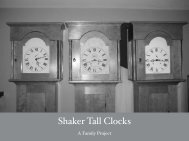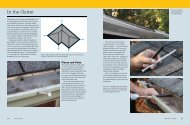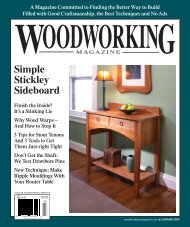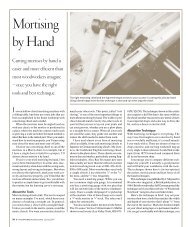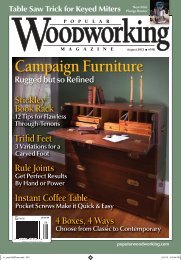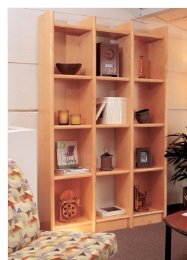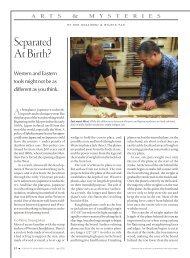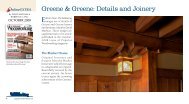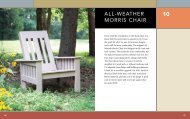Woodworking Magazine, Spring 2004 - Popular Woodworking ...
Woodworking Magazine, Spring 2004 - Popular Woodworking ...
Woodworking Magazine, Spring 2004 - Popular Woodworking ...
You also want an ePaper? Increase the reach of your titles
YUMPU automatically turns print PDFs into web optimized ePapers that Google loves.
Glossary<br />
<strong>Woodworking</strong>’s lexicon can be overwhelming<br />
for beginners. Following is a list of terms used in<br />
this issue. Check out woodworking-magazine.com<br />
for a complete and searchable glossary.<br />
arbor (n)<br />
A motor’s axis or rotating shaft to which a tool is<br />
attached, such as a table-saw blade or a router bit.<br />
Baltic birch (n)<br />
A high-quality birch plywood made from veneer of<br />
equal thickness. It has no voids. Widely used for<br />
furniture, it’s also known as “Finnish birch.” Unlike<br />
domestic plywood, such as “apple ply,” which comes<br />
in 4' x 8' sheets, Baltic birch is made in 5' x 5' sheets.<br />
bevel (v, n)<br />
To cut an inclined or sloping angle on a workpiece<br />
that is other than 90°; also, the angle itself.<br />
block plane (n)<br />
A small plane for trimming joints or end grain; the<br />
bevel on the cutter always faces up. Low-angle versions<br />
excel at trimming end grain.<br />
carcase (n)<br />
The frame or structure of a cabinet.<br />
chamfer (n, v)<br />
A beveled or grooved edge that is 45°.<br />
clearance hole (n)<br />
Ahole for a screw that allows the shank and threads<br />
to pass through without biting the wood.<br />
combination square (n)<br />
An all-metal, adjustable square that can measure<br />
90° and 45° angles. It is perhaps the most-used (and<br />
most dropped) tool when marking out joints.<br />
countersink (n, v)<br />
To cut a cone-shaped recess in a pilot or clearance<br />
Rail<br />
Panel<br />
Stile<br />
hole that allows a flat-head screw to seat flush<br />
or below the surface; also, the hole itself.<br />
crosscut (n, v, adj)<br />
A cut perpendicular to the grain of a board.<br />
dado (n, v) dados (pl) dadoing (v)<br />
A three-sided trench cut across the grain of a board.<br />
featherboard (n)<br />
A safety device comprising of flexible fingers that<br />
hold a workpiece against the fence or table during<br />
a cut; often constructed by cutting a number of slots<br />
in the end of a board.<br />
Forstner bit (n)<br />
A type of bit used to bore clean, flat-bottomed and<br />
generally larger holes.<br />
glue-up (n) glue up (v)<br />
The act of assembling parts with glue and clamps.<br />
grain pattern (n)<br />
The visual appearance of the wood grain; types<br />
include flat, straight, curly, quilted, rowed, mottled,<br />
crotch, cathedral, beeswing and bird’s eye.<br />
“When the only tool you have is<br />
a hammer, you tend to see every<br />
problem as a nail.”<br />
— Abraham Maslow (1908 - 1970)<br />
psychologist, philosopher<br />
groove (n)<br />
A three-sided trench cut with the grain of a board.<br />
kerf (n)<br />
The wood removed by a saw blade between the piece<br />
you keep and your offcut.<br />
kickback (n) kick back (v)<br />
The action of any number of woodworking machines<br />
to throw the workpiece back toward the operator. It<br />
usually occurs when wood gets caught between the<br />
rip fence and the blade. Splitters – and a dose of<br />
common sense – can prevent these.<br />
offcut (n, adj)<br />
A waste piece of lumber.<br />
outfeed (n, v, adj)<br />
The point where the workpiece exits a machine.<br />
panel (n)<br />
A large wood surface, sometimes made out of<br />
several boards glued edge-to-edge.<br />
A groove is cut<br />
with the grain.<br />
A rabbet can be cut<br />
with or across the grain.<br />
A dado is cut<br />
across the grain.<br />
pilot hole (n)<br />
A hole drilled to receive a screw’s threads that reduces<br />
splitting and increases accuracy.<br />
predrill (v)<br />
To drill a hole before driving a nail. This decreases<br />
the chance of splitting the wood.<br />
push stick (n)<br />
A hand-held safety device used for pushing wood<br />
past a cutter to keep the hands away from the blade.<br />
rabbet (n, v)<br />
A two-sided trench cut on the edge of a board.<br />
rail (n)<br />
The horizontal member of any frame, such as a door,<br />
window or face frame.<br />
rip (n, v, adj)<br />
A cut parallel to the grain of a board.<br />
rip fence (n)<br />
The movable guide on a table saw that’s parallel to<br />
the blade against which boards are referenced when<br />
making a rip cut.<br />
sheet good (n)<br />
Man-made wood product, such as plywood, particleboard<br />
or medium-density fiberboard (MDF).<br />
stile (n)<br />
The vertical member of any frame, such as a door,<br />
window or face frame.<br />
straight-grained (adj)<br />
The grain pattern that results when annual rings are<br />
perpendicular to the face and run parallel to the edge.<br />
tear-out (n) tear out (v)<br />
The chipping of an edge along the kerf.<br />
wood movement (n)<br />
The tendency of wood to expand and contract across<br />
the grain as its moisture content fluctuates in response<br />
to changes in relative humidity. WM<br />
woodworking-magazine.com ■ 29



